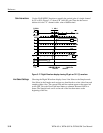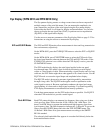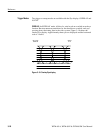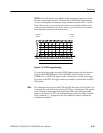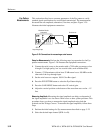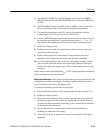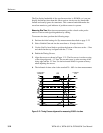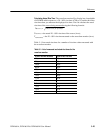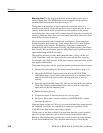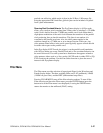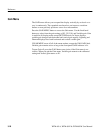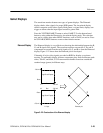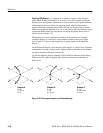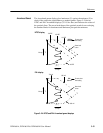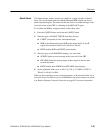
Reference
3–26
WFM 601A, WFM 601E & WFM 601M User Manual
Measuring Jitter. The Eye display in Overlaid mode provides a quick way to
measure timing jitter. The WFM 601M waveform monitor also provides an
automated Jitter measurement described on page 3–37.
Timing jitter is the deviation of signal transitions compared to those of a
reference clock. Ideally, all data bit transitions occur at equal intervals. In real
systems, factors such as noise, pulse distortion, and variations in bit patterns
cause timing jitter. Jitter results in Eye closure along the time axis, narrowing the
window in which the data values can be accurately determined. Data errors result
when the Eye becomes too narrow.
Jitter is characterized by both its magnitude and frequency. Signal transitions
deviate from their ideal position by a peak amount and at one or more frequen-
cies, depending on the sources. The frequency of the jitter is important in
determining its effect on the system. Typically, only high frequency jitter affects
data recovery. But low frequency jitter can affect time-critical operations such as
signal multiplexing and D/A conversion.
The waveform monitor provides three bandwidth filters: 10 Hz, 100 Hz, and
1 kHz. These filters only show jitter terms above the selected filter frequency.
For example, with 1 kHz selected, 50 Hz jitter is heavily attenuated while 10 kHz
jitter appears unattenuated.
To measure timing jitter with the waveform monitor, perform the following steps:
1. Perform the initial settings for Eye measurements described on page 3–22.
2. Choose the OVERLAY display mode (located in the EYE PATTERN
CONFIGure menu). In this mode, each of the ten bits of a scrambled serial
word are overlaid in the same location, showing peak jitter at each eye
crossing.
3. Select the appropriate BW Limit filter. Take two measurements: one with the
10 Hz filter, showing total broadband jitter, and one with the 1 kHz filter,
which removes the low-frequency jitter.
4. Enable the Timing Cursors.
5. Position the cursors to measure the Eye zero-crossing point.
6. Set Gain to X5 for better vertical resolution; use SWEEP MAG for better
horizontal resolution.
Suggested limits for jitter are 740 ps p-p over one horizontal line, measured with
the 1 kHz BW Limit filter. If composite D/A conversion is planned, use the
10 Hz BW Limit filter and the same 740 ps p-p limit.
To date, many of the jitter problems in systems have been the result of genlock-
ing clocks to other references such as the horizontal synchronization pulse.
Reference jitter transferred by genlocks into a serial system is typically between
20 and several hundred hertz. Also, the phase detection process used by the



